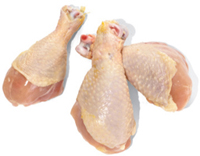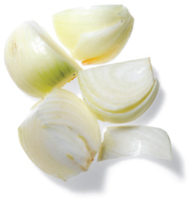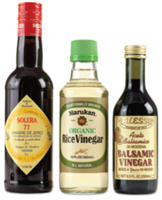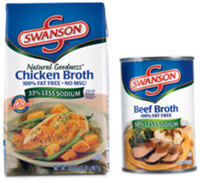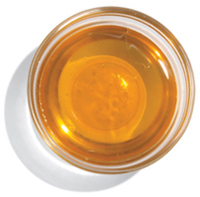In a land where more is more, it takes finesse to turn your favorite foods into healthy eats.
Sometimes food is more than just something that comes in a box, which you buy through the window of your car. Sometimes food is a rallying point around which an entire nation defines its ideals and identity. During World War I, for example, Americans stopped eating sauerkraut, because it was redolent of the hated Germans—instead, we consumed the same recipe, but called it “Liberty cabbage.” And when France said “no bien” to the American invasion of Iraq, our legislators responded by banning French fries from the congressional cafeteria, serving instead “Freedom fries.” (Although “grilled rack of lobbyist” would have done the country more good.)
Americans define themselves through food. Describe someone as “a meat-and-potatoes kind of guy,” and people instantly recognize him as “American as apple pie.” And the American classics described in this chapter will instantly trigger memories of happier days—or at least, of Happy Days, because every one of these recipes could have come out of Mrs. Cunningham’s kitchen.
That said, over the years classic American fare has been hijacked by “improvements” that have loaded it with caloric bells and whistles and supersize portions, turning former dietary muscle cars into minivans. And that’s not just bad for you—it’s bad for America.
Really! Consider this: In one study, Canadian researchers fed subjects two separate dinners, one with fast-digesting breads and potatoes and another with slow-digesting lentils and whole grains. Predictably, blood sugar levels spiked higher in the first group than the second. What’s shocking though, is that the next morning at breakfast, despite both groups eating the same bowl of cereal, the blood sugar levels of those in the bread-and-potatoes group spiked higher once again! That means that when you eat a poor dinner, you’re more likely to be tired, irritable, and impulsive at lunchtime. (Maybe they need to open some healthier restaurants on Wall Street?)
So if you want to spark a patriotic fervor and a personal economic recovery, watch what you eat. And the best way to take charge of that is to eat at home, if for no other reason than that you control portion size. When researchers in Pennsylvania varied the oversize portions of macaroni and cheese that they fed to the subjects of their study, they found that the more they put down on the plates, the more the subjects put away. With servings over a pound, subjects ate about 67 percent of the mac. When the portions bulged to more than 2 pounds, they ate nearly a quarter-pound more, which amounted to an extra 676 calories on their meal.
Here are some classic American meals, stripped of the fancy upgrades and turbo charged with all the fat-busting nutrition you could want.
Cook This!
The Law of Leftovers
Limp, lifeless, and soggy, leftovers invoke a near-universal sense of dread and disappointment in hungry eaters everywhere.
Not that again! Truth is, many
foods actually taste better the next day, after the flavors in a given dish have had a chance to spend some valuable time hanging out together. But reheat leftovers using the wrong method and you’ll sacrifice moisture, texture, and any shot at having a satisfying second helping. Follow these four rules to breathe delicious life back into last night’s dinner.
You might think that since leftovers are already cooked, slow
reheating would be ideal. In reality, slow reheating allows food to stay in the “danger zone” of between 40 and 140 degrees for too long. Best to blast food with high heat—325°F at the very lowest—for a short time to take it from cool to hot quickly.
Safety aside, taste and texture are hugely important factors to consider when reheating leftovers. And sadly, the reheating process too often leaves foods dry and unpalatable. Our favorite secret weapon is low-sodium chicken stock. Splash a bit on top of whatever you’re reheating—pastas, meats, even vegetables—and the moisture will be reabsorbed by the food, bringing life and flavor back to the dish.
Freezer Burned!
There’s nothing more disappointing than reaching into the freezer and discovering food that looks like it survived the Ice Age. The good news is, freezer burn doesn’t mean your food is unsafe—it just won’t taste as good. If you can trim away the burned portions, the rest of your food should be good as new. In the future, prevent freezer burn by double-wrapping food in freezer-specific bags, and squeeze out as much air as possible before storing.
As often as possible, add a layer of fresh flavor to leftovers after they’ve been heated. Pasta and soups benefit from a sprinkle of fresh parsley or basil, plus a drizzle of olive oil. Stir-fries could use some chopped scallion, toasted peanuts, and a spritz of lime. Meat and fish scream out for some fresh lemon juice and a sprinkling of flaky sea salt.
Though convenient, the microwave reheats food unevenly and has an uncanny ability to make crisp foods soggy and moist foods dry. Take the time to reheat your food correctly and you’ll be rewarded. Here’s how to handle it.
• Pizza: Microwaving cold pizza is only good if you like soggy, greasy slices. Instead, place one or two slices in a cast-iron pan set over low heat. Warm until the bottoms have crisped up slightly and the cheese has remelted. (Doing a large pie and want to
save time? Place on a cookie sheet and cook in a fully
preheated 500-degree oven for 4 to 5 minutes.)
• Steak, roasted chicken, and pork chops: Leave the meat out on the counter for 20 minutes before cooking.
Preheat an oven to 350°F. Heat a thin film of oil in a cast-iron skillet over medium heat. When hot, add the meat and cook until a nice crust has been reestablished on one side of the meat—2 to 3 minutes. Flip and place the whole skillet in the oven for 5 to 7 minutes, depending on the thickness of the leftovers.
• Chili, soup, and braises: The meat and vegetables in soups, stews, and braises absorb liquid as the leftovers sit, so to achieve the proper consistency, heat them slowly in a large sauce pan with up to a cup of low-sodium chicken stock (or vegetable stock or water). Stir constantly to ensure even heating.
• Pasta and Asian noodle dishes: Noodles act like sponges, soaking up moisture as they lie in wait with their saucy collaborators. (Which is why, if you have leftover noodles and sauce, try to store them separately.) Heat a nonstick skillet with a bit of olive oil. Add the pasta, along with a ¼ cup of low-sodium chicken stock or water per serving. Cook until the noodles are hot and the sauce is bubbling, about 3 to 4 minutes. Garnish with fresh chopped herbs (basil or parsley) and grated cheese.
• Burgers and chicken sandwiches: Preheat the oven to 350°F. Place the patties and chicken on a baking sheet and heat in the oven for 5 to 6 minutes, until the outside is hot to the touch. Toast a fresh bun and apply a new round of produce and condiments.
Good Timing
It’s easy to let leftovers sit in the fridge for days (weeks?) on end, but for your safety it’s important to eat or toss them before they go bad. Remember, if it looks, smells, or tastes weird, it’s probably a good sign you need to throw it out. Can’t tell? This chart breaks it all down.
| Dish |
Refrigerator Storage |
Freezer Storage |
| Uncooked sausage |
1–2 days |
1–2 months |
| Cooked meat |
3–4 days |
2–6 months |
| Pizza |
3–4 days |
1–2 months |
| Lunch meat (once opened) |
3–5 days |
1–2 months |
| Deli salads with mayo |
3–5 days |
Do not freeze |
| Casseroles |
3–5 days |
2–3 months |
| Hot dogs |
1–2 weeks |
1–2 months |
| Frozen dinners and entrees |
Do not refrigerate |
3–4 months |
| Frozen fruits and vegetables |
Do not refrigerate |
Up to 2 years |
Source: USDA Guidelines
Cook This!
The Crock-Pot Matrix
Why cook
slowly? Inexpensive cuts of meat also happen to possess an inordinate amount of flavor, but to enjoy it, you first need to break down all the connective tissue in the meat. Steady low temperatures do it best, which is why slow cookers are so useful: Dump a bunch of inexpensive meat and vegetables into the vessel, cover with your choice of liquid, press on, and disappear for 8 hours. When you come back, a pot filled with tender, flavorful, ready-to-eat meaty goodness will be awaiting.
SHORT RIBS
CHICKEN LEGS
Cook full legs or individual thighs and drumsticks.
PORK SHOULDER
LAMB SHANKS
CHUCK ROAST
DRIED BEANS
Dried beans cook effortlessly this way. Just cook over low for no more than 2 hours.
ONIONS
CARROTS
CELERY
Together, these three (known as mirepoix) form the base of most braises.
GARLIC
POTATOES
MUSHROOMS
Add vegetables that cook quickly during the last hour of the slow cooker—unless you don’t mind eating mush.
RED WINE
WHITE WINE
BEER
The flavor of the beer will really affect the final dish, so choose wisely.
VINEGAR
Balsamic, wine, rice wine, or sherry
SOY SAUCE
BEEF OR CHICKEN STOCK
TOMATO PASTE
A can of whole tomatoes makes for a rich, lusty braise.
DRIED MUSHROOMS
BAY LEAVES
FRESH HERBS
Thyme, rosemary, parsley
HONEY
GINGER
Step 1
Always fully brown your meat in oil first. The deeper the caramelization, the more flavor the final dish will have.
Step 2
After you’ve browned the meat and transferred to the slow cooker, deglaze the hot cooking pan by adding wine or other liquid and using a wooden spoon to scrape up any crusty bits stuck to the bottom. This will allow you to extract every last bit of flavor left behind by the meat.
Step 3
Use enough liquid (including the liquid from the pan) to cover the meat. Your best bet is to pair at least half stock with another flavorful liquid—wine, beer, vinegar, soy.
Step 4
Build flavor with vegetables, spices, herbs, and other add-ons. Top and cook on low for 8 hours or on high for 4. All of these recipes (and the other slow cooker recipes in the book) can be done without a slow cooker. Simply place in a 300°F oven until the meat begins to fall apart.
Four Bold Braises
Slow cookers make culinary geniuses out of people who can’t fry an egg. So what are you waiting for? Crock, lock, and load.
ASIAN SHORT RIBS
short ribs + onions + carrots + garlic + soy sauce + rice wine vinegar + beef stock + ginger + honey
LAMB OSSOBUCO
lamb shanks + mirepoix + garlic + red wine + stock + tomato paste + bay leaves
COQ AU VIN (RED WINE CHICKEN)
chicken legs + mirepoix + garlic + red wine + chicken stock + tomato paste + mushrooms
PORK RAGU
pork shoulder + mirepoix + white wine + stock + can of tomatoes + rosemary
Once cooked, shred the meat with a fork, combine with some of the vegetables and braising liquid, and serve over pasta or polenta.
Cook This!
Chicken Pot Pie
350 calories, 15 g fat (8 g saturated), 650 mg sodium
800 calories, 48 g fat (18 g saturated fat, 7 g trans fat), 1,090 mg sodium
Chicken Pot Pie
Pot pies may be one of America’s favorite comfort foods, but there’s nothing comforting about a dish that packs nearly 4 days’ worth of trans fat. We clear out the artery-clogging fats, cut the calories by 60 percent, and deliver an easy pot pie you’re bound to love.
You’ll Need:
2 Tbsp butter
1 onion, chopped
2 carrots, chopped
2 cloves garlic, minced
2 cups stemmed and quartered white or cremini mushrooms
2 cups frozen pearl onions
2 cups chopped cooked chicken (leftover or pulled from a store-bought rotisserie chicken)
¼ cup flour
2 cups low-sodium chicken broth, warmed
1 cup 2% or whole milk
½ cup half-and-half
1½ cups frozen peas
Salt and black pepper to taste
1 sheet puff pastry, defrosted
2 egg whites, lightly beaten
How to Make It:
• Heat the butter in a large sauté pan or pot over medium heat. When it’s melted, add the onion, carrots, and garlic and cook until the onion is translucent and the carrots begin to soften, about 5 minutes. Add the mushrooms and pearl onions and cook, stirring occasionally, for another 5 minutes. Stir in the chicken and the flour, using a wooden spoon to ensure the vegetables and meat are evenly coated with flour.
• Slowly pour in the chicken broth, using a whisk to beat it in to help avoid clumping with the flour (having the broth warm or hot helps smooth out the sauce). Once the broth is incorporated, add the milk and half-and-half and simmer for 10 to 15 minutes, until the sauce has thickened substantially and lightly clings to the vegetables and chicken. Stir in the peas. Season with salt and pepper.
• Preheat the oven to 375°F. Cut the pastry into quarters. Roll out each piece on a floured surface to make a 6" square.
• Divide the chicken mixture among 4 ovenproof bowls. Place a pastry square over the top of each bowl and trim away the excess with a paring knife; pinch the dough around the edges of the bowl to secure it. Brush the tops with the egg whites and bake until golden brown, about 25 minutes.
Makes 4 servings / Cost per serving: $3.84
Cook This!
Shrimp and Grits
340 calories, 10 g fat (4 g saturated), 610 mg sodium
1,160 calories, 45 g fat (12 g saturated), 1,648 mg sodium
Shrimp and Grits
Most shrimp that shows up on restaurant menus is either breaded and fried or sautéed in a bath of melted butter. Instead, we spike sautéed shrimp with scallions, cayenne, and crispy hunks of kielbasa to keep the calories, amazingly enough, below 400.
You’ll Need:
1 Tbsp canola oil
1 cup diced cooked turkey kielbasa
4 scallions, whites and greens separated, chopped
1 clove garlic, minced
8 oz fresh mushrooms (button, cremini, or shiitake), stems removed, sliced
1 pound shrimp, peeled and deveined
½ cup low-sodium chicken broth
Salt and black pepper to taste
½ tsp cayenne pepper
½ cup quick-cooking grits
¼ cup shredded Cheddar cheese
How to Make It:
• Heat the oil in a large cast-iron skillet or sauté pan over medium-high heat until lightly smoking. Add the kielbasa; cook for a few minutes, until lightly browned. Add the scallion whites, garlic, and mushrooms. Cook until the mushrooms are lightly browned, 3 to 4 minutes.
• Add the shrimp and continue cooking until the shrimp are just pink and firm to the touch. Stir in the broth and cook for another 3 minutes, until the liquid has reduced by half and the shrimp are cooked all the way through. Season with salt, pepper, and cayenne.
• While the shrimp are cooking, cook the grits according to the package instructions. When they’re thick and creamy, add the cheese and season with salt and pepper.
• Divide the grits and shrimp among 4 bowls and garnish with the scallion greens.
Makes 4 servings / Cost per serving: $3.24
Cook This!
Macaroni & Cheese
480 calories, 9 g fat (5 g saturated), 450 mg sodium
1,462 calories, 45 g saturated fat, 1,330 mg sodium
Macaroni & Cheese
Ask Americans what they would eat for their last meal on earth and most would likely tell you mac and cheese. Too bad restaurants and frozen-food purveyors start their macaroni and cheese with a base of cream and butter—a recipe for caloric calamity. This version is based on béchamel—butter, flour, and milk—which helps cut the calories in half. We add jalapeños and prosciutto for some spicy, smoky goodness; feel free to leave them out.
You’ll Need:
2 Tbsp butter
½ yellow onion, minced
2 Tbsp flour
3 cups milk
2 cups shredded extra-sharp Cheddar
Salt and black pepper to taste
1 lb elbow macaroni, penne, or shells
2 oz prosciutto or ham, cut into thin strips
½ cup panko bread crumbs
¼ cup grated Parmesan
How to Make It:
• Preheat the oven to 375°F.
• Melt the butter in a large saucepan over medium heat. Add the onion and cook until soft and translucent (but not browned), about 3 minutes. Add the flour and stir to incorporate into the butter. Pour in the milk a few tablespoons at a time, using a whisk to incorporate the flour and prevent lumps from forming. When all the milk has been added, allow the sauce to simmer for 10 minutes, until it begins to thicken. Stir in the cheese and season with salt and pepper.
• Cook the pasta according to the package instructions until al dente, drain, and return to the pot. Add the cheese sauce, jalapeños, and prosciutto and stir to fully incorporate. Divide the mixture among 6 individual crocks or pour into a large baking dish. Top with the bread crumbs and sprinkle with the Parmesan.
• Bake for 10 minutes. Turn on the broiler and broil until the bread crumbs are golden brown and crispy, about another 3 minutes.
Makes 6 servings / Cost per serving: $1.03
Cook This!
Honey-Mustard Salmon with Roasted Asparagus
370 calories, 21 g fat (6 g saturated), 530 mg sodium
1,126 calories, 25 g saturated, 1,567 mg sodium
Honey-Mustard Salmon with Roasted Asparagus
Many Americans view fresh fish as restaurant fare, food best left to professionals to skillfully prepare. But when you leave the fish cooking to “professionals” at places like Outback, Friday’s, and Applebee’s, your hopes of a healthy dinner may be sunk. Why blow the cash and the heavy caloric toll on a meal you can prepare at home in less time than it takes to order out? Plus, if you ever hope to get a kid to eat fish, this 3-minute sauce (which goes great on shrimp, scallops, and chicken, as well) is the key.
You’ll Need:
1 Tbsp butter
1 Tbsp brown sugar
2 Tbsp Dijon mustard
1 Tbsp honey
1 Tbsp soy sauce
½ Tbsp olive oil
Salt and black pepper to taste
4 salmon fillets (6 oz each)
How to Make It:
• Preheat the oven to 400°F. Combine the butter and brown sugar in a bowl and microwave for 30 seconds, until the butter and sugar have melted together. Stir in the mustard, honey, and soy sauce.
• Heat the oil in an ovenproof skillet over high heat. Season the salmon with salt and pepper and add to the pan flesh-side down. Cook for 3 to 4 minutes until fully browned and flip. Brush with half of the glaze and place the pan in the oven until the salmon is firm and flaky (but before the white fat begins to form on the surface), about 5 minutes. Remove, brush the salmon with more of the honey mustard, and serve with the asparagus.
Makes 4 servings / Cost per serving: $2.77
Cook This!
Turkey Meat Loaf with Spicy Tomato Chutney
330 calories, 7 g fat (1 g saturated), 970 mg sodium
520 calories, 36 g fat (16 g saturated, 1.5 g trans), 1,030 mg sodium
Turkey Meat Loaf with Spicy Tomato Chutney
Did you know it takes Boston Market 55 ingredients to make its meat loaf? Among those ingredients are three different uses of partially hydrogenated cottonseed oil, which gives each slice nearly a day’s worth of heart-threatening trans fat. Suffice it to say, it ain’t your mother’s meat loaf. But neither is our version, since rather than using a deluge of ketchup to keep it from drying out in the oven, we make an antioxidant-packed chunky tomato chutney to keep this meat loaf as tender and moist as any you’ve ever tasted.
You’ll Need:
½ Tbsp olive oil
1 medium onion, sliced
2 cloves garlic, minced
3 large tomatoes, seeded and chopped
½ cup roasted red peppers
¾ cup ketchup
¼ cup Worcestershire sauce
Pinch of red pepper flakes
Salt and black pepper to taste
1 Tbsp olive oil
1 medium onion, chopped
2 cloves garlic, minced
2 teaspoons salt
1 teaspoon pepper
½ tsp dried rosemary
3 lb ground turkey
1 cup bread crumbs
2 eggs, lightly beaten
How to Make It:
• For the chutney, heat the oil in a medium saucepan over medium-high heat. Cook the onion and garlic until translucent, then add the tomatoes and peppers and cook for a few minutes more, until the tomatoes are soft and saucy. Add the ketchup, Worcestershire, and pepper flakes and simmer for 10 to 15 minutes. Season with salt and pepper.
• Preheat the oven to 350°F.
• For the meatloaf, heat the oil in a medium skillet or sauté pan over medium heat. Sauté the onion and garlic until cooked through but not brown. Transfer to a bowl and gently mix in 1 cup of the chutney plus the remaining ingredients. (Don’t overmix, unless you like tough meat loaf.)
• Dump the meat loaf out into a baking dish and loosely form into a log. Cover with half of the remaining chutney.
• Bake the meat loaf for 60 to 90 minutes, until an instant-read thermometer inserted into the center reads 160°F. Serve the meat loaf with the remaining tomato chutney.
Makes 8 servings / Cost per serving: $2.76
Cook This!
Beer Brisket
470 calories, 24 g fat (8 g saturated), 670 mg sodium
1,092 calories, 88 g fat (30 g saturated)
Beer Brisket
Don’t mess with Texas, they say, and we try not to. But it’s hard not to fall in love with some of their more inspired culinary treasures like fajitas, nachos, and smoked brisket. They all share one thing in common, though: a need for nutritional improvement. We deliver that here with a leaner cut of beef, a light sauce, and a modest portion size.
You’ll Need:
3–4 lb lean brisket •
2 Tbsp chili powder
1 tsp smoked paprika ••
Salt and black pepper to taste
1 can or bottle dark beer
¼ cup apple cider vinegar
½ cup ketchup
2 Tbsp honey
• While a lean brisket is critical to keep the calories down, you’ll want at least a thin layer of milky white fat on top, which helps naturally baste the meat and keep it moist while it cooks.
•• Adds a deep smoky note to the crust of the meat without actually having to fire up the wood chunks.
How to Make It:
• Preheat the oven to 325°F. Rub the brisket all over with the chili powder, paprika, and plenty of salt and pepper. Place the brisket in a baking dish, pour in half of the beer and cover tightly with foil. Bake for 2 hours, until the brisket is very tender.
• At this point, you can eat the brisket and be really happy with the results. But to add that authentic char and smoky flavor, you’ll need to heat a gas or charcoal grill (if using charcoal, add a handful of soaked hickory or oak chips for great smoky flavor).
• Combine half of the remaining beer with the vinegar, ketchup, and honey and brush over the brisket. Place on the coolest part of the grill and cook until lightly charred all over, brushing with more of the beer mixture along the way. After the meat rests for 10 minutes, carve and serve with a bit more sauce or on a warm roll for a mean brisket sandwich.
Makes 8 servings / Cost per serving: $2.40
Cook This!
Prime Rib with Italian Herb Sauce
450 calories, 29 g fat (10 g saturated), 670 mg sodium
900 calories, 42 g fat (17 g saturated), 2,480 mg sodium
Prime Rib with Italian Herb Sauce
Consider this your ace in the hole for the holiday season. It’s an impressive dish that feels incredibly fancy, but requires nothing more than a quick rubdown and a few pulses from the food processor. With the herb-based sauce replacing horseradish cream, this roast outsizzles any prime rib you’d find at a buffet carving table.
You’ll Need:
1 Tbsp chopped fresh rosemary
3 cloves garlic, minced
1 Tbsp olive oil
1 prime rib roast (3 lb), trimmed of surface fat
Salt and black pepper to taste
SALSA VERDE
2 cups chopped fresh flat-leaf parsley
¼ cup fresh mint leaves
1 Tbsp Dijon mustard
2 Tbsp capers
2 or 3 anchovies (optional)
Juice of 1 lemon
2 Tbsp red wine vinegar
¼ cup olive oil
How to Make It:
• Preheat the oven to 450°F. Mix the rosemary, garlic, and olive oil. Season the roast all over with salt and pepper, then rub with the rosemary mixture. (For deeper flavor, do this at least 2 hours before cooking.)
• Place the roast in a large roasting pan or baking dish and bake for 20 minutes. Turn the heat down to 350°F and continue cooking until an instant-read thermometer inserted into the center of the roast reads 135°F, 30 to 45 minutes more. Remove from the oven and allow to rest at least 10 minutes before carving.
• While the beef rests, combine the parsley, mint, mustard, capers, anchovies (if using), lemon juice, and vinegar in a food processor. Pulse a few times to begin the chopping, then keep it running while you slowly add the olive oil until the mixture looks just like pesto. Serve slices of prime rib with the sauce drizzled over the top.
Makes 8 servings / Cost per serving: $3.72
Cook This!
Stuffed Chicken
500 calories, 19 g fat (4.5 g saturated), 790 mg sodium
1,304 calories, 94 g fat (42.5 g saturated), 2,147 mg sodium
Stuffed Chicken
The cheesy restaurant chicken dish (one likely to involve bacon and ranch dressing as well) will ruin any shot you have at a good day of eating. Apply those same appealing flavors at home to crispy stuffed chicken, though, and you’ll escape unscathed.
You’ll Need:
2 Tbsp olive oil
2 oz prosciutto, thinly sliced
4 cups baby spinach
¼ cup roasted red peppers
2 Tbsp pine nuts
Salt and black pepper to taste
4 boneless, skinless chicken breasts (6 oz each), pounded to ½" thickness (many markets sell chicken cutlets already pounded)
½ cup shredded fontina or mozzarella cheese
2 eggs, lightly beaten
2 cups bread crumbs, preferably panko
How to Make It:
• Heat ½ tablespoon olive oil in a sauté pan or cast-iron skillet over medium heat. When hot, add the prosciutto strips. Cook until lightly crisp, about 1 minute. Add the spinach, peppers, and pine nuts. Cook until the spinach is fully wilted, about 2 to 3 minutes. Season with salt and pepper. Reserve.
• Lay the chicken breasts flat on a cutting board. Season lightly with salt and pepper. Divide the spinach mixture and cheese among the breasts, cheating the components toward the top of the chicken. Wrap one end of the chicken around the mix and roll tightly, as if making a burrito. Secure the ends with toothpicks.
• Combine the eggs in a shallow bowl. Mix the bread crumbs on a plate with salt and pepper. Dredge the chicken first in the eggs, then in the crumbs, making sure they’re fully coated.
• Wipe out the skillet. Heat the remaining oil in the pan over medium heat. Add the chicken and cook on all sides until the crust is golden brown and the chicken is cooked all the way through, about 10 minutes.
Makes 4 servings / Cost per serving: $4.00
Cook This!
Turkey Chili
330 calories, 6 g fat (1 g saturated), 490 mg sodium
579 calories, 35 g fat, 1,655 mg sodium
Turkey Chili
Though we’ve never been shy about professing our undying affection for chili, it’s not without its dangers, namely soaring sodium counts and reliance on fatty ground beef. Go lean by using ground turkey and build flavor with spices, beer, and a bit of chocolate.
You’ll Need:
1 Tbsp canola oil
1 large onion, chopped
2 cloves garlic, minced
1 tsp ground cumin
½ tsp dried oregano
¼ cup chili powder
⅛ tsp ground cinnamon
2 bay leaves
2 lb lean ground turkey
2 Tbsp tomato paste
1 piece (1 oz) dark chocolate or
1 Tbsp cocoa powder
1 bottle or can (12 oz) dark beer
1 Tbsp chopped chipotle pepper
1 can (28 oz) whole peeled tomatoes
1 can (14 oz) white beans, rinsed and drained
1 can (14 oz) pinto beans, rinsed and drained
Salt and black pepper to taste
Hot sauce or cayenne (optional) to taste
Raw onions, shredded cheese, chopped scallions, lime wedges, sour cream (optional)
How to Make It:
• Heat the oil in a large pot over medium heat. Add the onion and garlic and cook until the onion is translucent, about 5 minutes. Add the cumin, oregano, chili powder, cinnamon, and bay leaves and cook for another 2 to 3 minutes, until the spices are very fragrant.
• Add the turkey and tomato paste and stir with a wooden spoon until the turkey is no longer pink. Add the chocolate, beer, chipotle, and tomatoes, squeezing each tomato between your fingers so that it’s still chunky but not whole. Turn down the heat and simmer for 45 minutes.
• Add the beans and season with salt and pepper. Taste; if you like your chili hotter, add your favorite hot sauce or a few pinches of cayenne. Cook until the beans are hot. Serve topped with your choice of garnishes.
Makes 6 servings / Cost per serving: $3.65
Cook This!
Cornmeal Catfish with Corn Salsa
430 calories, 20 g fat (4 g saturated), 460 mg sodium
570 calories, 37 g fat (5 g saturated), 670 mg sodium
Cornmeal Catfish with Corn Salsa
Nearly all catfish you encounter on restaurant menus has one thing in common: a long soak in hot fat. We’ve never quite understood the appeal. Once food is battered and fried, doesn’t it all start to taste the same? This catfish creation mimics the satisfying crunch of a fried fillet and the corn salsa provides more flavor than you’d ever find in a coat of soybean oil.
You’ll Need:
4 tsp canola oil
1 ear corn, kernels removed from the cob
1 can (16 oz) black beans, rinsed and drained
1 avocado, pitted, and cut into cubes
Juice of 1 lime, plus wedges for garnish
1 jalapeño, minced
Salt and black pepper
1 cup cornmeal
⅛ tsp cayenne pepper
4 catfish fillets (6 oz each) •
• Catfish is affordable and found in most markets, but flounder and tilapia are good substitutes.
How to Make It:
• Heat 1 teaspoon of the oil in a medium saucepan over medium-high heat. Add the corn kernels and cook, stirring occasionally, until they’re lightly browned, about 5 minutes. Add the beans and warm through. Transfer to a bowl and stir in the avocado, lime juice, and jalapeño; season with salt and pepper.
• Pour the cornmeal onto a large plate; season with the cayenne, 1 teaspoon salt, and ¼ teaspoon pepper. Dredge the fillets in the cornmeal until evenly coated.
• Heat the remaining 3 teaspoons of oil in a large nonstick skillet or sauté pan over medium heat. When the oil is hot, add the catfish and cook for 4 to 5 minutes per side, until the coating is golden and crispy and the fish flakes easily. Serve the fish topped with the salsa, along with additional lime wedges, if you like.
Makes 4 servings / Cost per serving: $4.14
Cook This!
Loaded Pizza
300 calories, 14 g fat (6 g saturated), 780 mg sodium
800 calories, 40 g fat (16 g saturated), 1,780 mg sodium
Loaded Pizza
Ordering a supreme pizza for delivery is an open invitation for caloric calamity. Best-case scenario, you’re looking at 250 calories a slice; worst case, 500 or more. Here, we use Boboli’s whole-wheat thin crust shell as a low-cal, fiber-rich base. We then load the pizza with a team of nutritional all-stars (red peppers, artichokes, fresh basil) and a good amount of turkey pepperoni. Torn deli ham or Canadian bacon would also work great here.
You’ll Need:
12" Boboli whole-wheat thin
pizza crust
1 cup tomato-basil pasta sauce (we like Muir Glen)
2 cups shredded part-skim mozzarella
15 slices turkey pepperoni
½ cup sliced onion
½ cup chopped roasted red peppers
½ cup chopped green olives
2 cloves garlic, minced
½ tsp red pepper flakes
1 jar (6 oz) artichoke hearts, drained
1 cup fresh basil leaves (optional) •
• Fresh basil is a perfect pizza garnish, but unless you have other uses for it, it’s probably not worth the extra $2 or $3 price tag.
How to Make It:
• Preheat the oven to 400°F. Cover the crust with sauce and then cheese. Sprinkle with the pepperoni, onion, peppers, olives, garlic, pepper flakes, and artichokes.
• Bake for 12 to 15 minutes, until the cheese is melted and bubbling. Top with the basil (if using) and serve immediately.
Makes 4 servings / Cost per serving: $3.07
Cook This!
Herb Roast Chicken with Root Vegetables
420 calories, 10 g fat (2 g saturated), 610 mg sodium
880 calories, 45.5 g fat (12.5 g saturated), 2,220 mg sodium
Herb Roast Chicken with Root Vegetables
They say you can judge a cook by how well they roast a chicken. If that’s the case, Boston Market’s cooks need a little help. (Surprised?) This recipe produces an incomparably moist bird, simple enough to make on a weeknight, but elegant enough to serve to guests.
You’ll Need:
2 cloves garlic, minced
1 Tbsp finely chopped fresh rosemary •
Zest and juice of 1 lemon
1 Tbsp olive oil
1 chicken (4 lb)
Salt and black pepper to taste
1 large russet potato, sliced into ⅛" rounds
2 onions, quartered
4 large carrots, cut into large chunks
• Almost any herb works here: thyme, parsley, oregano, basil, or sage.
How to Make It:
• Preheat the oven to 450°F. Mix the garlic, rosemary, lemon zest, and half of the olive oil.
• Working on the chicken, gently separate the skin from the flesh at the bottom of the breast and spoon in half of the rosemary mixture; use your hands to spread it around as thoroughly as possible. Spread the remaining half over the top of the chicken and then season with plenty of salt and pepper.
• Mix the potato, onions, carrots, remaining olive oil, and a good pinch of salt and pepper. Arrange the vegetables in the bottom of a roasting pan and place the chicken on top, breast side up. Roast for 20 to 30 minutes, until the skin is lightly browned.
• Reduce the oven temperature to 350°F and roast for another 30 minutes or so. The chicken is done when the juices between the breast and the leg run clear and an instant-read thermometer inserted deep into the thigh reads 155°F.
• Remove from the oven and allow to rest for 10 minutes before carving. Serve with the vegetables.
Makes 4 servings / Cost per serving: $3.90
Cook This!
French Pot Roast
500 calories, 12 g fat (4 g saturated), 640 mg sodium
727 calories, 34 g fat (14 g saturated, 4 g trans fat), 2,900 mg sodium
French Pot Roast
Every culture has its version of pot roast, that amazing slow-cooked amalgamation of hearty meat and vegetable chunks and flavorful broth. When it comes to picking the best rendition, we have to side with Julia Child, who believed the French boeuf bourguignonne was the world’s finest pot roast. Here’s an easy, healthy version to tackle.
You’ll Need:
2 strips bacon, cut into ½" pieces
¼ cup flour
Salt and black pepper to taste
2 lb chuck roast, excess fat removed, cut into 1" pieces
½ bottle dry red wine
2 cups low-sodium beef broth
2 Tbsp tomato paste
2 bay leaves
2 cups frozen pearl onions
½ lb button mushrooms, stems removed
1 cup frozen peas
How to Make It:
• Preheat a large skillet or nonstick sauté pan over medium-high heat. Cook the bacon until the fat is rendered and the bacon is crisp. Remove the bacon with a slotted spoon and drain on paper towels; set aside. Leave the pan on the heat.
• Combine the flour and plenty of salt and pepper in a sealable plastic bag. Working in batches, add the beef and shake until the pieces are lightly covered; remove the beef from the bag and shake off the excess flour. Add the pieces to the hot pan and cook until all sides are golden brown.
• Remove the beef and add to a slow cooker. When all the beef has been browned, add 1 cup wine to the hot pan and scrape up any brown bits from the bottom with a wooden spoon. Pour over the beef, along with the rest of the wine, the tomato paste, bay leaves, and bacon pieces.
• Set the slow cooker to high and cook for 4 hours, until the beef is tender and falls apart with pressure from a fork. In the last 30 minutes of cooking, add the pearl onions and mushrooms. Right before serving, add the peas and simmer for a few minutes to cook through. Discard the bay leaves.
• Serve the stew by itself or over mashed potatoes or buttered egg noodles with a good ladle of the cooking broth.
Makes 4 servings / Cost per serving: $4.00




